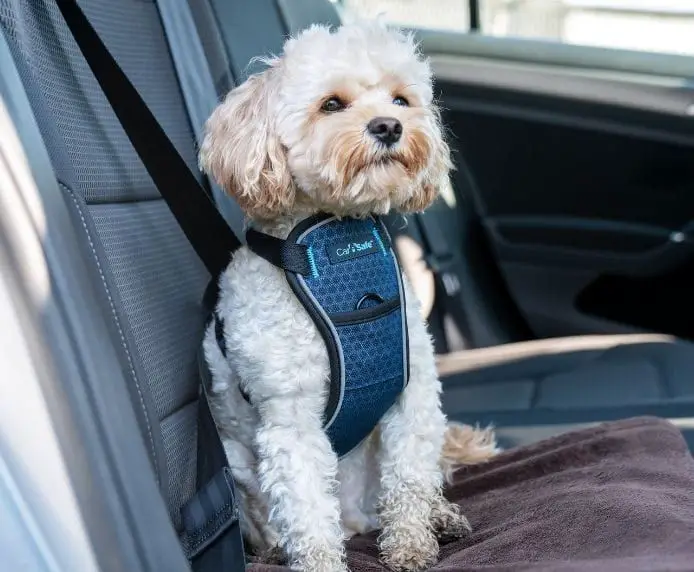Introduction
Dogs riding unrestrained in vehicles can be dangerous to themselves, their owners, and others on the road. An unrestrained dog is more likely to be injured or killed in a crash, and they can also serve as distractions to drivers, increasing the risk of accidents. For these reasons, many states have laws requiring that dogs be properly secured when riding in vehicles.
At a minimum, most states with restraint laws require that dogs be prevented from interfering with or distracting the driver, often by being secured in a crate or carrier or restrained by a seatbelt harness. Some states simply prohibit allowing dogs to ride in truck beds or hanging their head out the window. A few states go further and mandate specific restraints like harnesses. Enforcement and penalties vary widely.
This article provides an overview of dog restraint laws on a state-by-state basis. We’ll cover the specifics of what’s required, exemptions that may apply, and tips for selecting proper restraints to keep your dog safe while traveling.
Background on Unrestrained Dogs in Cars
Having a dog unrestrained in a vehicle poses serious safety risks. When a car brakes suddenly, an unrestrained dog can become a dangerous projectile that can injure passengers or even cause an accident by interfering with the driver’s ability to control the vehicle. Unrestrained dogs are also at risk of being injured during sudden stops, acceleration, or in the event of a collision.

According to studies, an unrestrained 10-pound dog in a 30 mph crash exerts approximately 500 pounds of force on impact. At 50 mph, that force increases to over 1,000 pounds. This amount of force can prove fatal to both the dog and any passengers impacted. Even in less severe accidents, unrestrained dogs can suffer from blunt trauma, concussions, internal bleeding, broken bones, and road rash. Tragically, many unrestrained dogs are ejected from vehicles in crashes, greatly increasing their chances of being killed.
Restraining dogs properly while driving is crucial to protect them, vehicle occupants, and other vehicles on the road. Without restraints, an excited dog may also attempt to climb into the driver’s lap or otherwise distract them. This can be incredibly dangerous at highway speeds or in heavy traffic.
State Laws Requiring Dog Restraints
Several states have enacted laws requiring drivers to properly restrain dogs while traveling in vehicles. The specific requirements vary by state, but most mandate the use of a harness, tether, crate, or other device to prevent dogs from roaming freely in the car.
States with laws requiring dog restraints include:
- Arizona
- Connecticut
- Maine
- Massachusetts
- New Hampshire
- New Jersey
- Rhode Island
Some cities and municipalities also have their own restrictions, such as Seattle and Austin. The laws typically require dogs to be in a crate or carrier, harnessed, or attached to a seat belt when riding in a vehicle. Enforcement varies, with some areas treating unrestrained dogs as a primary traffic violation.
Types of Required Restraints
The most common types of restraints that states require for securing dogs in vehicles are harnesses, crates, and seat belts:

Harnesses – These specially designed harnesses attach to a seat belt in the car. They distribute force across the dog’s chest and shoulders in the event of an accident or sudden stop. Harnesses should be properly sized and fitted for each dog.
Crates – Secure crates made of plastic, wire, or fabric can restrain dogs in the car. Crates should be appropriately sized for the dog with enough room to stand up and turn around. They must be securely strapped or anchored to the vehicle.
Seat Belts – Some states allow using regular seat belts to secure dogs in the back seat. The seat belt attaches to the dog’s harness for restraint. Seat belts should be locked and not retractable to prevent excess movement.
Enforcement and Penalties
A law is only as good as its enforcement. Though most states have some form of legal requirement for securing dogs while driving, the penalties and enforcement vary widely. Some states treat unrestrained dogs as a primary traffic violation, while others only issue citations if the driver is stopped for another reason.
In California for example, a first offense for an unrestrained dog results in a $100 fine. Subsequent violations can incur fines up to $250. California Highway Patrol is authorized to stop and cite drivers solely for unrestrained pets. However, in Illinois the law is rarely enforced on its own. Unsecured pet fines start at $75 but are usually tacked onto other traffic citations.
States like Hawaii and New Jersey have restraint laws but no explicit penalties spelled out. However, police can issue careless driving tickets to drivers with loose pets they believe to be driving negligently. How strictly restraint laws are enforced often comes down to an individual officer’s discretion.
While monetary fines may be small, drivers can potentially face criminal charges if an unrestrained pet causes an accident leading to injuries or property damage. Community service at animal shelters is also sometimes ordered for offenders. But perhaps the greatest deterrent is the risk of serious injury, or worse, to beloved family pets in a crash.
Exemptions to Restraint Laws
Although most states require dogs to be restrained in moving vehicles, there are some exemptions in certain situations where restraints are not required by law:
- Unrestrained transportation may be allowed for working dogs such as police dogs, search and rescue dogs, herding dogs, hunting dogs, or other service animals. Their duties may require immediate exit from a vehicle, so restraints could interfere with their work.
- Some states make exceptions for dogs traveling in the bed of a pickup truck or in a slide-in camper. However, this practice is still dangerous and not recommended.
- If a dog’s crate or carrier is securely fastened and meets size requirements, some states may exempt them from wearing an additional restraint inside.
- Certain medical exemptions may apply if a dog has a documented physical condition that prevents wearing a restraint.
- Puppies under a specified age (e.g. 8 weeks) may be exempt until they are old enough for a harness or restraint.
Tips for Safely Restraining Dogs
Properly restraining dogs while driving is crucial for everyone’s safety. Here are some best practices for keeping your dog secure:
Use a crash-tested harness or carrier. Look for brands that have been successfully crash-tested. Harnesses distribute force across your dog’s chest and shoulders, while carriers contain them in a sturdy kennel.

Attach restraints to the seat belt or LATCH system. Connecting restraints directly to the vehicle provides the most secure attachment. Use metal buckles and avoid elastic or plastic clasps which can break.
Check the fit. Make sure harnesses are snug but not constricting. Your dog should be able to stand and turn around when buckled in.
Use short lead connections. Minimize slack by using short leads to limit your dog’s movement. Long leads allow too much dangerous mobility.
Never attach restraints to collars. Collars can choke or injure dogs if pulled on forcefully during sudden braking or crashes.
Consider your dog’s anxiety. An anxious dog may need additional containment like a partially-covered crate carrier.
Bring toys for comfort. Familiar toys can help relax dogs unused to being restrained.
Taking these precautions allows you to travel safely with your furry friends. Restrained properly, dogs have the best chance of avoiding injury whenever traveling by car.
Alternatives to Restraints
While restraints like harnesses and crates are the most secure options, some owners prefer alternatives that don’t physically attach the dog to the vehicle. Here are a few popular alternatives:
Dog-Friendly Vehicles: Some SUVs and minivans have dog-friendly features like slide-in ramps, climate controls, and special upholstery that make it safer and more comfortable for loose dogs. The increased space also gives dogs more room to move around.
Travel Crates: Plastic travel crates that fit in the cargo area provide confinement while allowing dogs to stand, sit, and turn around comfortably. They’re secured with straps or cargo anchors.
Seat Belt Tethers: These short tethers attach to the seat belt receptacle on one end and to the dog’s harness on the other, keeping the dog close but not fully restrained.
Backseat Barriers/Nets: Sturdy netting or grates block access to the front seats while allowing air circulation and vision. Dogs are confined to the backseat area.
While less secure than fixed restraints, these alternatives can work well for calm, trained dogs. But owners should consider the risks and follow any state laws requiring restraints.
Importance of Restraining Dogs in Vehicles
Properly restraining dogs while driving provides substantial benefits for both dog and human safety. Unrestrained dogs in moving vehicles can become projectiles in an accident or sudden stop, potentially causing serious injuries to themselves, drivers, and passengers. Restraining dogs can help prevent the following:

- Injuries and fatalities from dogs being thrown around or ejected from vehicles
- Driver distraction and accidents from loose dogs interfering with vehicle operation
- Dogs jumping out open windows or doors
- Dogs escaping vehicles and becoming lost or hit by other cars
In addition to safety benefits, restraining dogs also provides other advantages such as:
- Preventing dogs from bothering or distracting the driver
- Keeping dogs from wandering around vehicles while driving
- Lessening dogs’ anxiety during travel by confining them to a safe space
- Discouraging undesirable behavior like jumping from seat to seat
Proper restraint use is a simple way for dog owners to fulfill their responsibility for their pets’ welfare. Restraining dogs while driving is a commonsense measure that prevents injuries and saves lives.
Conclusion
As shown, laws regarding dog restraints in vehicles vary by state. While some states have no laws at all, others require dogs to be secured with a harness, tether or crate when riding in a vehicle. The goal of these laws is to protect dogs and prevent distracted driving accidents. Restraining dogs properly keeps them safe in the event of a crash or sudden stop. It also keeps them from interfering with the driver. Though a few exemptions may apply in certain states, it’s best for the safety of your pet and others on the road to always secure dogs when traveling. Following pet restraint laws shows you’re a responsible owner. More importantly, it saves the lives of our furry companions.